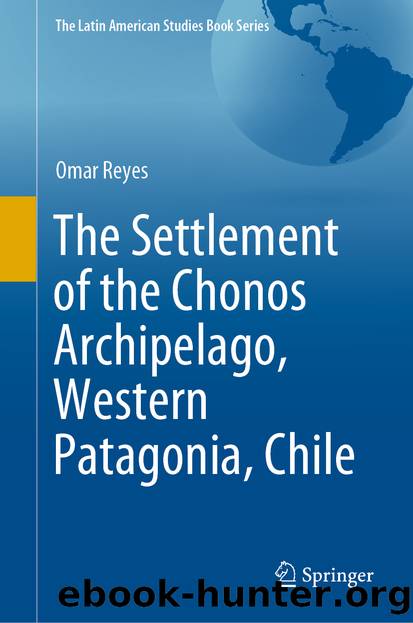The Settlement of the Chonos Archipelago, Western Patagonia, Chile by Omar Reyes

Author:Omar Reyes
Language: eng
Format: epub
ISBN: 9783030543266
Publisher: Springer International Publishing
Fig. 4.17View of Cholguero Isla Izaza 2. Part of the shells are seen to be deposited in the intertidal zone and part of the area is covered by vegetation. The test pit dug in the intertidal can also be seen, revealing that the base of the shell-midden projects below sea level
The MNI was determined as 4 individuals, with one infant (aged between 8 months and 2 years) and three adults (one adult male aged between 25 and 40, one adult female older than 20 years and one adult of indeterminate age and sex). In the laboratory, it was decided to reassociate the elements, assigning them to hypothetical male and female individuals based on a significant difference in the size of the remains and the possibility of articulating some of the elements. A third adult individual was identified by the presence of a mandible which does not match either of the crania present and a rib that could not be associated with either of the two rib assemblages reassociated (Galimany 2016).
It was not possible to carry out anthracological analysis of the pieces of bark recovered because no wood adhered to them, which is necessary to identify the species. Both pieces have been cut and rounded to a similar diameter (approximately 21 cm). Their edges are eroded, however, there are perforations or âeyeletsâ, and in two of them pieces of animal tendon tied in a knot. Their function is unknown; they might be part of an offering, funeral trappings or some kind of instrument. To date, this find is the only cultural element recovered from an ossuary that has clearly been placed in association with the human remains deposited.
The samples of bark (IBEN5-1) and human rib (IBEN5-2) were taken from the surface in the field (and not reassigned in the laboratory). Subsequently another set of dates was obtained for the bone remains reassigned to 4 individuals, all of which were dated: IBEN5-3 (maxillary right third molar of an adult male, aged between 25 and 40 years), IBEN5-4 (right rib of infant, aged between 8 months and 2 years), IBEN 5â5 (mandibular left central incisor of an adult of indeterminate age and sex) and IBEN 5â6 (maxillary left second premolar of an adult female aged over 20 years, the same individual as in the rib sample noted above IBEN5-2).
The Isla BenjamÃn 5 site is a shelter used exclusively for funerary purposes. Despite the scant shelter offered for human habitation (e.g. comfortable movement, effective protection), the site served for funerary purposes as a narrow shelter away from the water, partly protected from the weather by the rock overhang and the forest cover. The site had not been altered by later anthropic activities. No other types of activity were recorded or could be inferred from the cultural and bio-anthropological materials recovered.
The results of the dates obtained from all the individuals deposited on the surface of the shelter gave a range betweenâ~570 and 230 years cal. BP (Reyes et al. 2019b, Table 4.1). The extreme calibrated
Download
This site does not store any files on its server. We only index and link to content provided by other sites. Please contact the content providers to delete copyright contents if any and email us, we'll remove relevant links or contents immediately.
| Africa | Americas |
| Arctic & Antarctica | Asia |
| Australia & Oceania | Europe |
| Middle East | Russia |
| United States | World |
| Ancient Civilizations | Military |
| Historical Study & Educational Resources |
The Bomber Mafia by Malcolm Gladwell(1179)
Submerged Prehistory by Benjamin Jonathan; & Clive Bonsall & Catriona Pickard & Anders Fischer(1161)
Facing the Mountain by Daniel James Brown(1130)
The Dawn of Everything by David Graeber & David Wengrow(1102)
The Way of Fire and Ice: The Living Tradition of Norse Paganism by Ryan Smith(1030)
Wandering in Strange Lands by Morgan Jerkins(1014)
Tip Top by Bill James(1001)
Driving While Brown: Sheriff Joe Arpaio Versus the Latino Resistance by Terry Greene Sterling & Jude Joffe-Block(1000)
Evil Geniuses: The Unmaking of America: A Recent History by Kurt Andersen(998)
Red Roulette : An Insider's Story of Wealth, Power, Corruption, and Vengeance in Today's China (9781982156176) by Shum Desmond(996)
F*cking History by The Captain(966)
It Was All a Lie by Stuart Stevens;(939)
White House Inc. by Dan Alexander(904)
Evil Geniuses by Kurt Andersen(900)
Treasure Islands: Tax Havens and the Men who Stole the World by Nicholas Shaxson(879)
American Dreams by Unknown(857)
American Kompromat by Craig Unger(847)
The Fifteen Biggest Lies about the Economy: And Everything Else the Right Doesn't Want You to Know about Taxes, Jobs, and Corporate America by Joshua Holland(814)
The First Conspiracy by Brad Meltzer & Josh Mensch(811)
